How the Public Sector Can Unlock Critical Value from Data Using Cloud Computing

Public sector organisations have a lot to gain by adopting a cloud computing approach to service delivery. Cloud computing has the potential to unlock critical value and lead to massive cost savings. The public sector must be confident that the benefits do not compromise institutional values or core requirements.
Below, we examine concerns and demonstrate through use cases how cloud computing can unlock critical value.
Growth in Cloud Computing
Let's begin with a brief look at the growth in cloud computing by sampling the 2020 IDG Cloud Computing Survey and see what insights we can glean.
The survey measures cloud computing trends amongst technology decision-makers. Some of the main highlights include:
- There is a steady incline since 2007, which is no surprise. 81% of organisations have at least one application or a portion of their computing infrastructure in the cloud. This figure represents an increase from 73% in 2018.
- 32% of the total IT budget will go to cloud computing in 2021.
- 30% of respondents are currently migrating or deploying Business Intelligence (BI), Data Warehousing (DW), and Data Analytics (DA) to the cloud as clients understand the cloud and their needs better. 7% of respondents are building their BI, DW, and DA in the cloud from scratch.
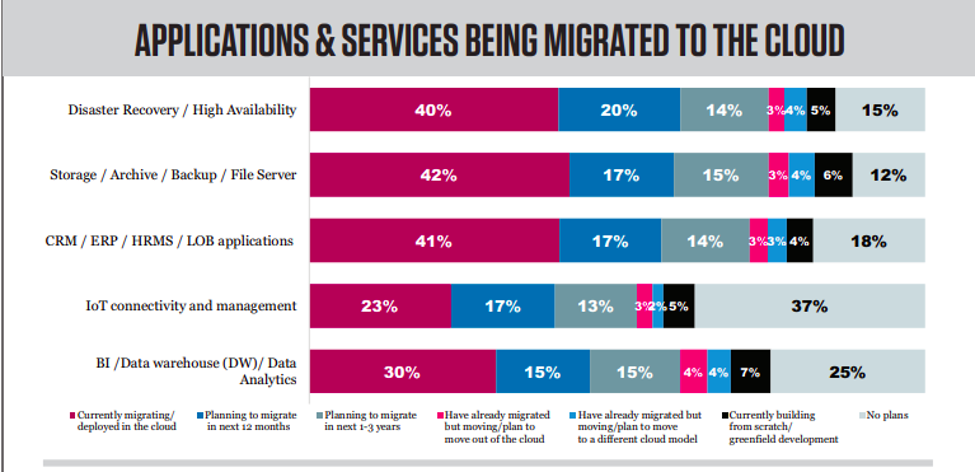
(Image source: 2020 IDG Cloud Computing Survey)
Unfortunately, while the growth in cloud computing in the private sector has been stellar, the same cannot be said of the public sector.
For example, in 2013, the UK Government launched the Cloud First policy to encourage public sector organisations to migrate to the cloud.
Fast forward to 2021, there is some growth as evidenced by spending by government agencies on the UK Government's G-Cloud, a series of framework agreements with suppliers, and a kind of public sector "app store."

UK Central Government Spending in G-Cloud
(Image source: UK Government G-Cloud)
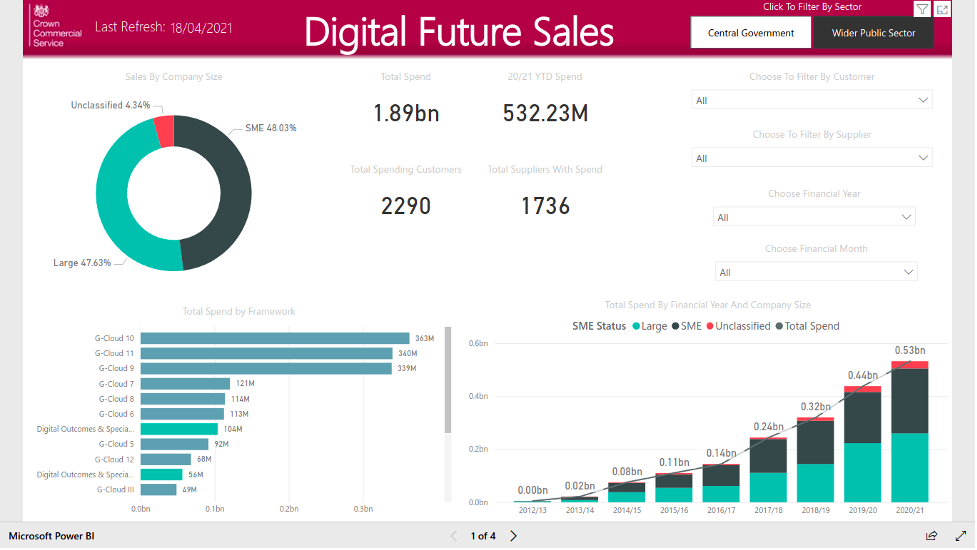
Wider Public Sector Spending in G-Cloud
(Image source: UK Government G-Cloud)
Looking at the charts above, you can only conclude that while the central government has prioritised cloud computing, the wider public sector is lagging.
Better uptake has the potential to stimulate interoperability, improve collaboration, reduce costs, all while offering flexibility and security benefits. However, public sector organisations still have reservations about cloud computing.
On-premises security vs Cloud security
Safety appears to be one of the main concerns that public sector managers have with moving their data to the cloud.
There is a feeling that on-premises (on-prem) infrastructure is more secure. The fact is security has nothing to do with the location of IT infrastructure but more to do with good processes, compliance, governance, and education.

(Image source: zsah)
On-premises Analytics vs Cloud Analytics
On-premises infrastructure is finite and has performance limitations in terms of data storage and computing power for analytical purposes. On the cloud, scalability is unlimited.
You can have as much storage, computing power, virtual machines, and other deployments as you want. Cloud computing makes extracting value from data much easier, and with pay-as-you-go cloud services, much cheaper. There is also faster data recovery in the event of an emergency.

(Image source: zsah)
LOOKING FOR A TECHNOLOGY PARTNER?
Our partners are technology companies whose solution requires an element of managed hosting, they operate cross-industry and are leaders in their respective fields.
Sounds like you? Learn more about how we could be your partner.
How Cloud Analytics Works
To help you understand how cloud analytics works to unlock critical value, we deconstruct it into three steps below:
- Ingest: We load the data into the cloud computing platform. There are various data loading processes and methodologies at the disposal of cloud computing companies. For example, various Apache tools, Syncsort, and WaveFront are all examples of methods used to load data.
- Process: We take the raw data and transform it into information. There are also lots of different tools for this depending on the type of data and desired output. Examples include Google BigQuery and Databricks.
- Analyse: We then analyse the information to get insights that can inform decision-making. Examples of tools used in this step include Tableau, Power BI, Qlik, and many more.
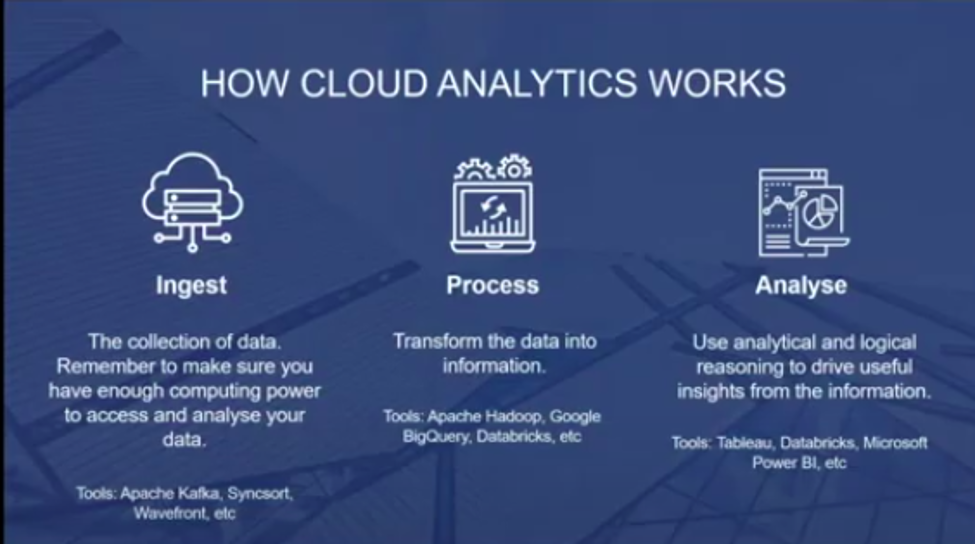
(Image source: zsah)
Why Public Sector Needs Cloud Analytics
There are three main areas where the public sector can leverage the power of cloud analytics:
- Higher agility: With cloud computing, public sector organisations can quickly and easily deploy and scale up and down resources, data, and applications. Nothing demonstrates this better than the COVID-19 pandemic that has forced the public sector worldwide to accelerate their digital transformation programmes and pay more attention to analytics. Possible applications run the gamut from connecting and harvesting insights from city-wide Internet of Things (IoT) to economic stimulus tax relief systems in a matter of days; only the cloud can rise to these new challenges.
- Lower costs: Cloud computing tangibly lowers the total cost of infrastructure ownership significantly. Future upgrades no longer need to be paid for upfront, and the IT departments don't need to be large.
- Public user satisfaction: The public who is the consumer expects the same service quality provided by private entities. This is only possible by tapping into the seamless power and flexibility of the cloud.
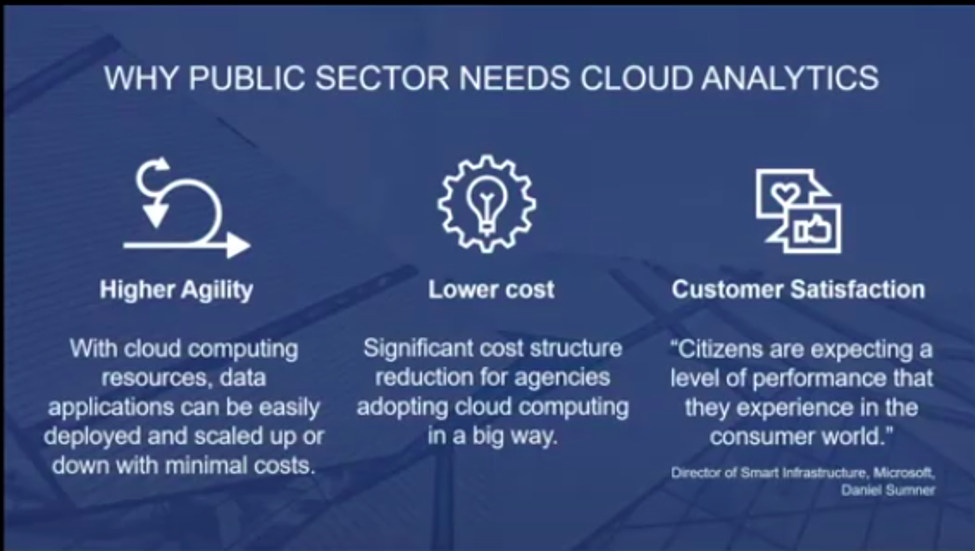
(Image source: zsah)
Public Sector Cloud Analytics Use Cases
There are ample examples of how public sector organisations have leveraged the power of cloud computing worldwide. Let's consider a few cases that stand out for their effectiveness and return on investment.
Public Sector Cloud Use Case 1: Netherlands Water Management System
The Netherlands is an engineering marvel. Over a third of the country is below sea level. Land reclamation began as early as the 14th century, but it wasn't until the Zuiderzee Works of 1918 when the government implemented an official land reclamation plan using a series of dikes, canals, and pumps.
Today, almost 20% of the land area is recovered from the Northern Sea. Cloud computing is currently helping public administrators to analyse real-time data from 15,000 sensors. The sensors detect changes in water levels, flow, and infrastructure. With this information, quick, informed decisions are made to mitigate the risk of flooding.
Sensor data also supplements weather forecasts to determine whether it makes financial sense to grit roads for icy conditions.
The use of cloud-based predictive analytics has saved the Netherlands money and saved lives.
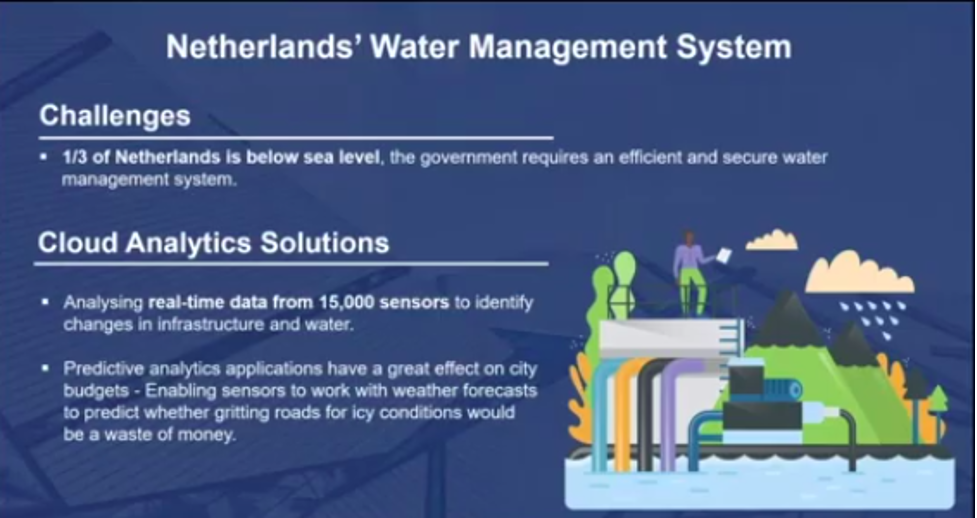
(Image source: zsah)
Public Sector Cloud Use Case 2: Crime Prevention in North Carolina
In North Carolina, antiquated information systems, shrinking law enforcement budgets and resources, and increased data volumes have hindered law enforcement's effectiveness for years.
A key challenge was obtaining an individual's prior criminal records due to data fragmentation - a common problem with the public sector.
The state government solved this problem by implementing an on-demand, web-based application that integrates criminal offender data from multiple historical systems. The Criminal Justice Law Enforcement Automated Data Services (CJLEADS) platform provides law enforcement, courts, probation, and parole agencies with a complete history of a criminal offender.
The returns on investment have been enormous. Four years after implementation, the state estimated the return on investment based on time saved, improved productivity, and lives saved to be around $28 million.
The state also realises savings by eliminating unnecessary processes. CJLEADS analytical reports help the courts to:
- Identify offenders on the court docket currently held in state prisons or county jails. This reduces failure-to-appear processing.
- Research outstanding warrants and orders for arrest and serve them to offenders appearing in court or while in jails.
- Positively identify offenders using photographic images and thus reduce the time spent processing and paperwork to clear citations or charges filed to the wrong individual.
Other wins using this system include an online vehicle search system that is particularly helpful to law enforcement during hit-and-run incidences.
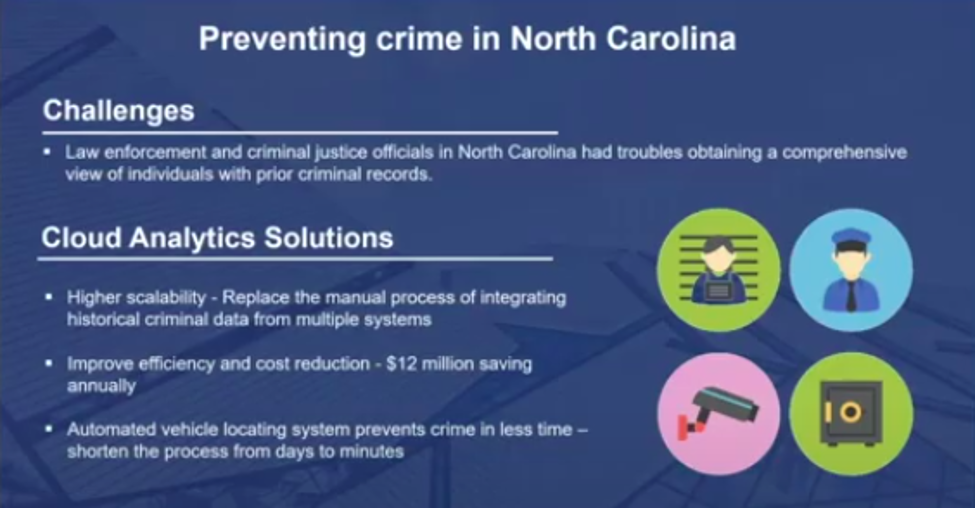
(Image source: zsah)
Public Sector Cloud Use Case 3: Safer Roads in Western Australia
The number of road accidents and casualties has historically been above the Australian national average in Western Australia.
The Road Safety Commission of Western Australia addressed this problem by turning to cloud-hosted artificial intelligence and advanced analytics.
Using a visual data mining and machine learning solution, the agency rapidly prototyped a machine learning model that produces a probability of killed or seriously injured (KSI) statistics.
With this information, they could apply simple fixes such as adding warning and stop signs in the right places and locations of service stops.
The result was a 25% reduction in road accidents compared to the previous manual methods.
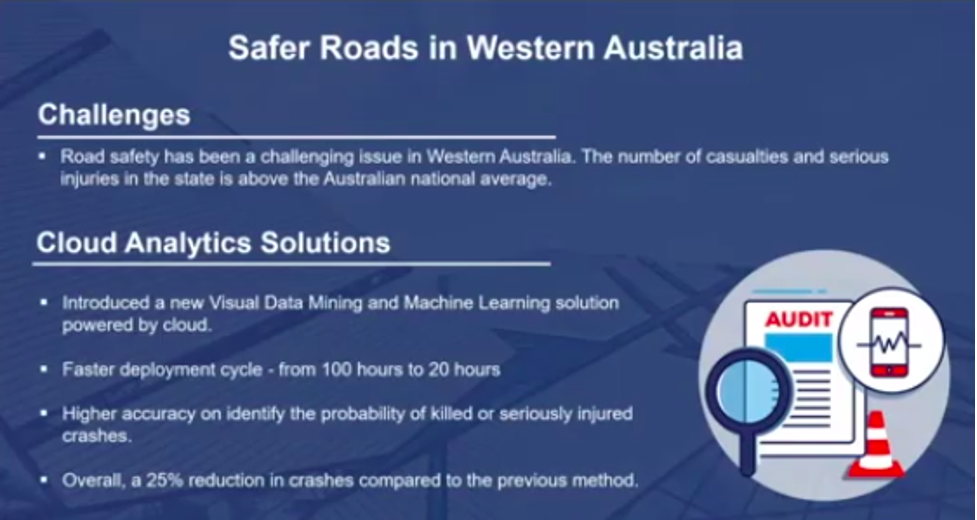
(Image source: zsah)
zsah's Direction of Travel as a Service
zsah built this free service to address air travel challenges due to the COVID-19 pandemic, specifically, predicting flight cancellation chances.
Airport officials and travellers have a big challenge with this issue, so we created a cloud analytics platform that pulls data from lots of different sources, processes, and analyses it to help the aviation industry monitor recovery routes from the impact of the pandemic.
Users can see when a route looks like it might recover or predict when it can recover. It offers a detailed view of the pandemic and general travel restrictions, including detailed maps and feeds.
We put this tool together to show the immense possibilities of unlocking critical data using cloud computing.

(Image source: zsah)
How Public Sector Organisation can Protect their Data in the Cloud
With good security implementations, public sector organisations have nothing to fear by migrating to the cloud. Below are a few best practice pointers to secure data in the cloud.
- Multifactor authentication: Strong passwords with multifactor authentication are the first line of defence. Passwords should be at least eight characters long and combine uppercase letters, lowercase letters, numbers, and special symbols. The user should authenticate the login with another separate system such as mobile text codes, email codes, QR codes, etc.
- Encryption: Data must be encrypted in storage and during transmission.
- Limiting access by IP address: Limit access to the cloud analytics platform by IP address so that you prevent nefarious characters on the Internet from finding the server and attempting to log in.
- Reputable, audited cloud provider: Finally, choosing your cloud provider carefully is the most critical security strategy. Find out how the provider deals with data breaches and security. Interrogate their policies and processes in this area to ensure you deal with a provider with the right skills and experience.
zsah's Data and Analytics Offerings
zsah helps both private and public sector organisations to focus on their core activities. We are based in central London and offer managed cloud services via our own Gridz cloud platform, AWS, Azure, and Google Cloud.
zsah is multi-cloud and can therefore deal with any cloud platform. We also offer NetOps, DevOps, Data Analytics, and a host of advisory services.
We have over 20 years of experience offering these services and hold several public sector accreditations. Some highlights in this regard include:
- ISO27001 certification on information security.
- ISO9001 certification on quality management.
- We are an HM Government G-Cloud supplier and Crown Commercial Service Supplier.
We also work with several clients in the public sector, such as the UK Planning Inspectorate, the National Health Service (NHS), and the Department for Transport.
For more information on how zsah can help your organisation unlock critical value using cloud computing, get in touch with us today, or reach out to us on Twitter – @zsahLTD and LinkedIn - zsah.
Recommended reading: 7 Things to Look For in a Technology Consulting Service.

